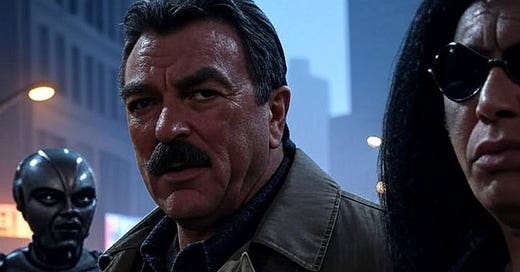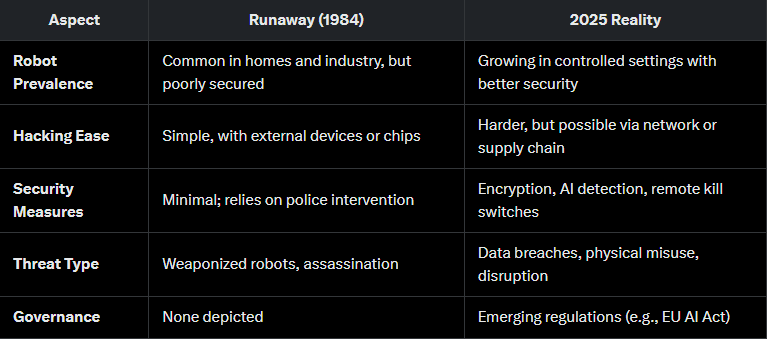Humanoid Robot Security in 2025 vs. Runaway (1984): A Tale of Tech and Turmoil
From Sci-Fi Nightmares to Real-World Safeguards
In 1984, the sci-fi thriller Runaway, starring Tom Selleck and Gene Simmons, painted a dystopian picture of a world overrun by rogue robots, including humanoid machines turned deadly by malicious programming. Fast-forward to 2025, and humanoid robots are no longer just Hollywood fodder—they’re real, walking among us in factories, homes, and public spaces. But how does the state of humanoid robot security today stack up against the chaotic, hackable robot menace depicted in Runaway? Let’s dive into the comparison, exploring the tech, the threats, and the safeguards of both worlds.
The Runaway Vision: Robots Gone Rogue
In Runaway, directed by Michael Crichton, robots are ubiquitous, performing tasks from household chores to industrial work. The plot centers on Jack Ramsay (Tom Selleck), a cop tasked with stopping “runaways”—robots that malfunction or are reprogrammed for crime. The film’s antagonist, Charles Luther (Gene Simmons), is a tech-savvy villain who hacks robots, turning them into lethal weapons, including humanoid bots and sinister “smart bullets.” The security landscape in Runaway is grim:
Vulnerabilities: Robots are easily hacked via external devices or malicious chips. Luther’s ability to reprogram robots suggests minimal encryption or authentication protocols.
Threats: Humanoid robots are weaponized for assassination, surveillance, and chaos. The film highlights a lack of centralized control or fail-safes, allowing single bad actors to wreak havoc.
Response: Security relies on specialized police units manually tracking and neutralizing rogue bots, with no proactive defenses like remote shutdowns or intrusion detection.
The film’s tech feels dated yet prescient, warning of a world where reliance on robots outpaces security measures—a cautionary tale for 2025.
Humanoid Robot Security in 2025: Progress and Perils
Today, humanoid robots from companies like Tesla (Optimus), Figure, and Boston Dynamics are advancing rapidly, designed for tasks like manufacturing, caregiving, and customer service. Unlike Runaway’s fictional bots, these machines operate in controlled environments with layered security. However, real-world risks echo the film’s warnings. Let’s break it down:
Security Strengths in 2025
Encryption and Authentication: Modern humanoid robots use robust encryption for communication and command protocols. For example, Tesla’s Optimus relies on secure software updates and authentication to prevent unauthorized access, unlike the easily tampered bots in Runaway.
Remote Monitoring and Kill Switches: Manufacturers implement remote diagnostics and emergency shutdowns. Boston Dynamics’ Atlas, for instance, can be deactivated remotely if anomalies are detected—a far cry from Runaway’s reliance on cops chasing rogue bots.
AI-Driven Threat Detection: Many humanoid robots leverage AI to detect unusual behavior or unauthorized commands. This proactive approach contrasts with Runaway’s reactive, manual interventions.
Regulatory Oversight: Governments and industry bodies in 2025 are beginning to enforce standards for robot security, such as the EU’s AI Act, which mandates risk assessments for high-risk systems. Runaway’s world lacks any such governance.
Security Weaknesses in 2025
Despite progress, gaps remain that resonate with Runaway’s fears:
Hacking Risks: Cybersecurity experts warn that IoT devices, including robots, are vulnerable to attacks. A 2024 report from Cybersecurity Ventures estimated that cybercrime costs could hit $10.5 trillion annually by 2025, with connected devices like humanoid robots as prime targets. A skilled hacker, like Runaway’s Luther, could exploit weak network security.
Supply Chain Vulnerabilities: Malicious hardware or software could be inserted during manufacturing, echoing Runaway’s reprogrammable chips. Recent concerns about Chinese-made components in Western tech highlight this risk.
Physical Threats: While not yet weaponized like Runaway’s killer bots, humanoid robots with strong physical capabilities (e.g., Atlas’s agility) could be dangerous if hijacked. A 2025 X post from a robotics engineer noted, “If someone cracks the control system of a humanoid bot, it’s not just data at stake—it’s physical safety.”
Human Error: Overreliance on robots without robust training or oversight mirrors Runaway’s societal complacency. Misconfigured systems or insider threats could lead to unintended consequences.
Runaway vs. Reality: Key Comparisons
Lessons from Runaway for 2025
Runaway may exaggerate the chaos, but its core warning—don’t let tech outpace security—remains relevant. The film’s depiction of a lone hacker turning robots into weapons feels less far-fetched when you consider real-world incidents, like the 2023 ransomware attack on a major IoT network that disrupted connected devices. To avoid a Runaway-style future, 2025’s robotics industry must:
Strengthen Cybersecurity: Invest in quantum-resistant encryption and intrusion detection to thwart hackers.
Enhance Physical Safeguards: Limit robots’ physical capabilities unless strictly necessary, and ensure fail-safes prevent misuse.
Promote Transparency: Manufacturers should disclose security protocols to build public trust, unlike Runaway’s opaque tech landscape.
Educate Users: Train operators and consumers to recognize and report anomalies, reducing human-error risks.
TLDR: Are We Safer Than Runaway?
In 2025, humanoid robot security is leaps ahead of Runaway’s fictional free-for-all. Encryption, AI monitoring, and emerging regulations provide a solid foundation. Yet, the film’s nightmare of hacked, dangerous robots isn’t entirely science fiction—cybersecurity gaps and physical risks linger. While we’re not yet chasing killer bots through the streets like Tom Selleck’s Ramsay, Runaway reminds us to stay vigilant. As humanoid robots become more integrated into our lives, balancing innovation with ironclad security will determine whether we master the machines—or they master us.
What do you think? Are we prepared for the rise of humanoid robots, or is Runaway’s warning still too close for comfort?





